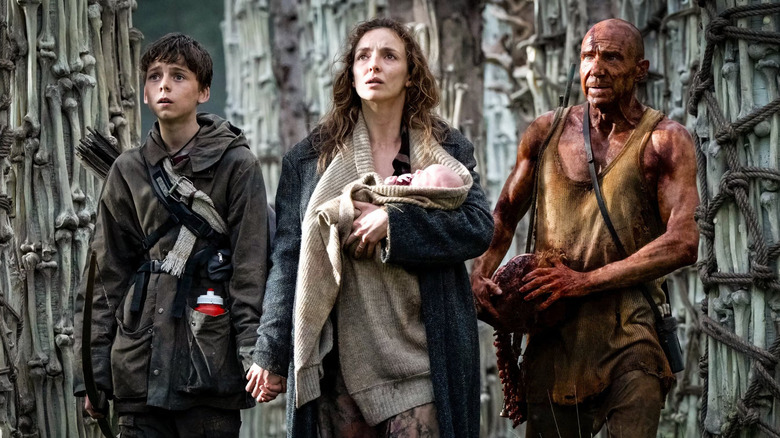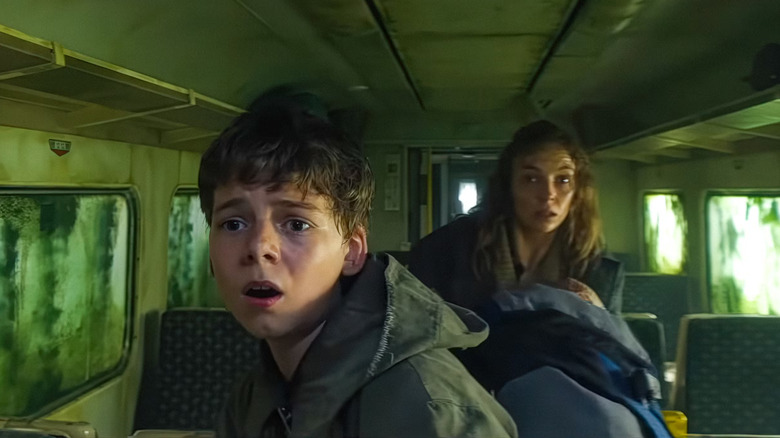28 Years Later's Most Shocking Scene Changes The Zombie Movie Series Forever
Spoilers ahead for "28 Years Later."
There are a lot of gamechangers in "28 Years Later," the long-awaited third film in the "28 Days Later" franchise. There's the Jimmy Savile-inspired ninjas in the final scene, the implication of ravens being at least partially in tune with some of the infected, and of course that giant zombie penis that was flopping around all movie. I'm not sure why that one particular infected man had to be hung, but I suppose that's why I'm a movie critic and Danny Boyle's a movie director.
The actual craziest scene, however, is one that happens halfway through the film. Spike (Alfie Williams) and his mother Isla (Jodie Comer) come across a pregnant infected woman in labor. In an act both brave and foolish, Isla decides to help the infected woman give birth. Not only is the baby perfectly healthy, but the infected woman displays a level of awareness we're not used to seeing from them. She understands Isla is trying to help, and lets her deliver the baby.
Sure, she attacks Isla shortly afterward, but even that isn't necessarily a sign that she's returned to a total rabid state. It could mean she's simply trying to take back her baby, an action that at least displays an understanding of her own motherhood that you'd think would be beyond her. In "28 Weeks Later," Don forgets all love he has for his wife within seconds of his infection; the infected woman, however, might still see her non-infected child as someone to protect.
The implications of infected people being able to procreate are massive, as are the implications that come with their offspring being born healthy. But perhaps the most important part of the baby delivery scene is not the baby itself, but the way the alpha (an infected man who's grown unnaturally big and strong) reacts to it.
The infected are capable of forming a family unit. Now what?
The alpha, referred to by the non-infected as Samson (Chi Lewis-Parry), shows up shortly after the baby's birth to brutally murder Swedish soldier Erik (Edvin Ryding), who shot and killed the infected mother. Samson sees the baby in Isla's hands and furiously chases after her, although not before grieving over the infected woman's death. The implication's pretty clear: Samson's the father of the baby, and he cares for both the infected woman and for his newborn child. Does he express this care in the healthiest of ways? Perhaps not, but he's still displaying a level of sentimentality he's not supposed to have.
Making Samson and the other alphas even scarier is the way they've formed their own rituals. When they kill an animal (or Erik, for that matter), they rip the being's head off, complete with a trailing spinal column, and wedge it in a tree to mark their territory. Barbaric, sure, but there is a clear method to the madness.
Much like how Don from "28 Weeks Later" seems more intelligent than the zombies from "28 Days Later," Samson seems smarter than Don. The virus seems to have continued evolving, moving towards a point where the infected behave increasingly like the non-infected. Perhaps they'll always be hostile towards regular humans, but within their own group of infected perhaps they're slowly developing their own human-like civilization.
It's possible that this franchise, which has the next sequel filmed already and another sequel planned afterward, is making a point about the non-infected being not much better than the infected. Samson may kill the healthy humans indiscriminately, but is this really that different from the approach of Jamie (Aaron Taylor-Johnson), who teaches Spike to kill the infected without hesitation or compassion?
Granted, Jamie's approach to dealing with the infected is understandable, but the baby delivery scene is the first moment in the franchise where Jamie's approach no longer seems like the answer. Shortly after this, the pacifist Dr. Kelson enters the narrative, and his decision to repeatedly spare Samson's life never comes back to bite him or Spike. "28 Years Later" marks the series' first time raising the idea of peace between the infected and non-infected, even if it doesn't commit to it just yet.
Isla, the non-infected baby born from infected parents, may be vital going forward
The whole storyline with the baby Isla feels familiar. We've seen bits of this already in "Children of Men," another dystopian film where the protagonists have to somehow smuggle a baby out of an area that's aggressively hostile towards babies. In "Children of Men," just as in "28 Years Later," the baby represents hope. In the former, the baby proves that humanity's fertility crisis doesn't have to be the end of civilization, and in the latter the baby shows that something good can still come out of something so horrible. It seems unbelievable that a baby so healthy could be borne from an infected couple so grotesque (Dr. Kelson credits the placental barrier with protecting baby Isla from the pathogen). This storyline is a dose of radical optimism tossed into a franchise that's otherwise deeply cynical.
Of course, the jury's still out on whether little Isla is really healthy or not. This could be another Alice Harris situation, with Isla turning out to be a carrier of the virus despite being immune herself. Or this could be some new, even smarter variation of the virus, where it doesn't activate until she's old enough to do some real damage.
If the Isla storyline continues to be as optimistic as "28 Years Later" implies, maybe Isla coulc even hold the cure for the virus. The circumstances of her birth are far more extreme than those of Ellie's from "The Last of Us," for instance, but they are similar. Ellie's immune because her mother was infected shortly before giving birth. Baby Isla's mother was infected far earlier, but maybe the same basic logic applies.
Baby Isla could be a savior of humanity (well, a savior of the UK), or she could be what dooms humanity yet again. Which one is she? We'll have to wait until January 2026, when "28 Years Later: The Bone Temple" releases in theaters, to find out.


